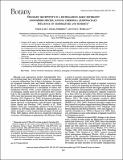Por favor, use este identificador para citar o enlazar a este item:
http://hdl.handle.net/10261/33350COMPARTIR / EXPORTAR:
 SHARE SHARE
 CORE
BASE CORE
BASE
|
|
| Visualizar otros formatos: MARC | Dublin Core | RDF | ORE | MODS | METS | DIDL | DATACITE | |

| Título: | Stigmatic receptivity in a dichogamous early-divergent angiosperm species, Annona cherimola (Annonaceae): Influence of temperature and humidity |
Autor: | Lora, Jorge CSIC ORCID ; Herrero Romero, María CSIC ORCID ; Hormaza Urroz, José Ignacio CSIC ORCID | Palabras clave: | Annona cherimola Annonaceae Cherimoya dichogamy environmental modulation stigmatic receptivity |
Fecha de publicación: | ene-2011 | Editor: | Botanical Society of America | Citación: | Lora J, Herrero M, Hormaza, JI. Stigmatic receptivity in a dichogamous early-divergent angiosperm species, Annona cherimola (Annonaceae): Influence of temperature and humidity. American Journal of Botany 98 (2): 265-274 (2011) | Resumen: | • Premise of the study: A variety of mechanisms to prevent inbreeding have arisen in different angiosperm taxa during plant evolution. In early-divergent angiosperms, a widespread system is dichogamy, in which female and male structures do not mature simultaneously, thus encouraging cross pollination. While this system is common in early-divergent angiosperms, it is less widespread in more recently evolved clades. An evaluation of the consequences of this system on outbreeding may provide clues on this change, but this subject has been little explored. • Methods: In this work, we characterized the cycle and anatomy of the flower and studied the influence of temperature and humidity on stigmatic receptivity in Annona cherimola, a member of an early-divergent angiosperm clade with protogynous dichogamy. • Key results: Paternity analysis reveals a high proportion of seeds resulting from self-fertilization, indicating that self-pollination can occur in spite of the dichogamous system. Stigmatic receptivity is environmentally modulated—shortened by high temperatures and prolonged by high humidity. • Conclusions: Although spatial and temporal sexual separation in this system seems to effectively decrease selfing, the system is modulated by environmental conditions and may allow high levels of selfing that can guarantee reproductive assurance. | Descripción: | 9 Pag., 8 Fig. | URI: | http://hdl.handle.net/10261/33350 | DOI: | 10.3732/ajb.1000185 | ISSN: | 0002-9122 | E-ISSN: | 1537-2197 |
| Aparece en las colecciones: | (EEAD) Artículos (IHSM) Artículos |
Ficheros en este ítem:
| Fichero | Descripción | Tamaño | Formato | |
|---|---|---|---|---|
| HerreroM_AmJBot_2011.pdf | 1,95 MB | Adobe PDF |  Visualizar/Abrir |
CORE Recommender
SCOPUSTM
Citations
36
checked on 20-abr-2024
WEB OF SCIENCETM
Citations
33
checked on 26-feb-2024
Page view(s)
691
checked on 24-abr-2024
Download(s)
2.335
checked on 24-abr-2024
Google ScholarTM
Check
Altmetric
Altmetric
NOTA: Los ítems de Digital.CSIC están protegidos por copyright, con todos los derechos reservados, a menos que se indique lo contrario.
